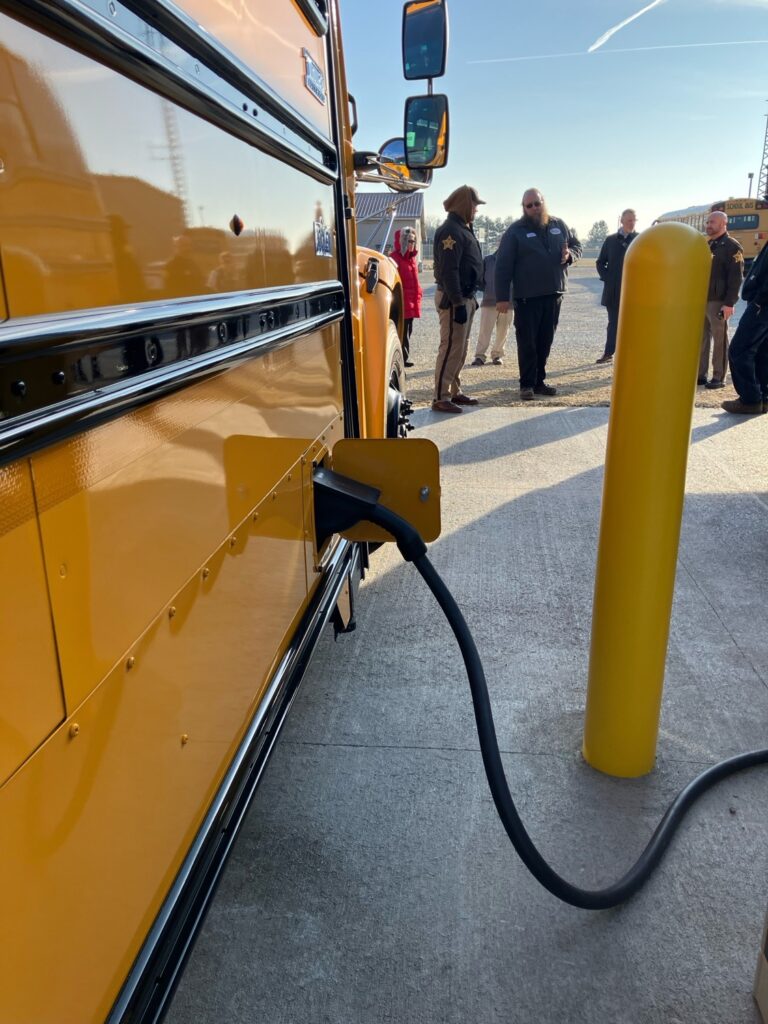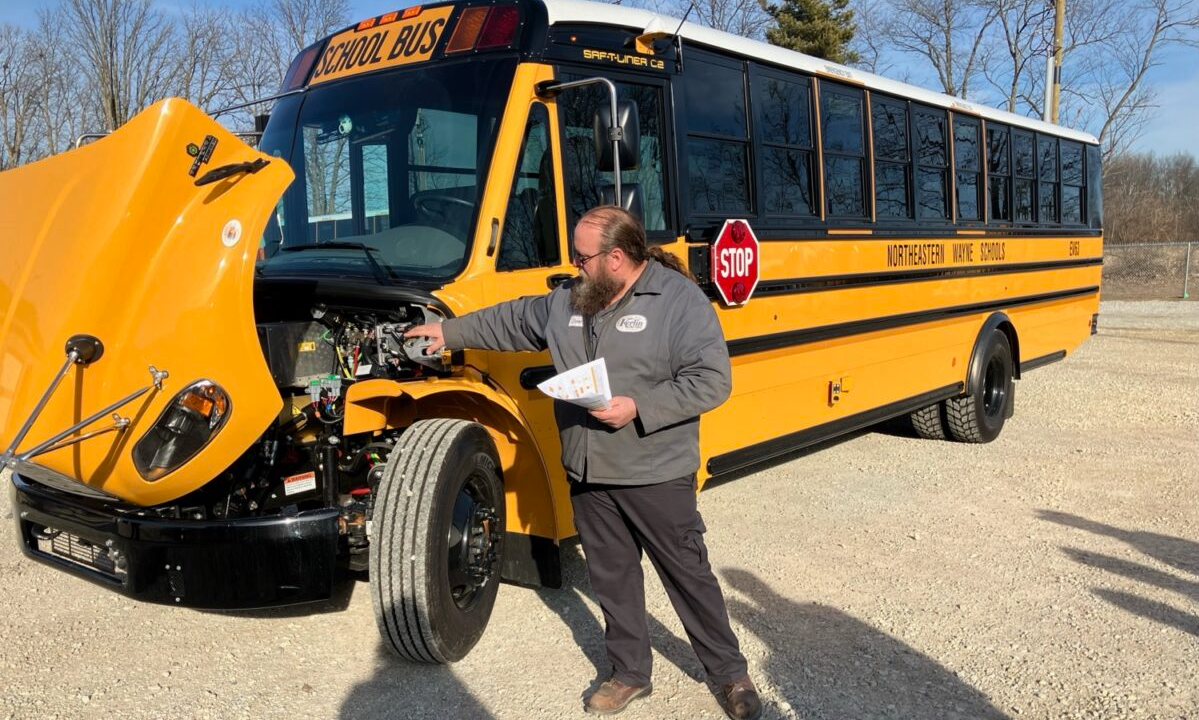Shhh: Listen for the new buses
Richmond, Ind. (Western Wayne News) — As a new yellow bus started forward, one of the half-dozen school staff on board hollered out from her seat in the back, “Oh my gosh! We’re moving.”
Two days later, a post on the Northeastern Wayne School Corp. website gave the reason: “Listen carefully; they are quiet,” wrote Kelly Plank, the district’s director of curriculum and instruction, about six new school buses that arrived a week earlier.
“One of the comments we get from drivers is that students are quieter because they aren’t trying to talk over the noise of the bus,” said bus driver Jason Farlow.
The only sound made by the bus is a soft whirring when the driver presses the accelerator and the electric engine starts. Riders hear gravel crunching under tires as the bus starts moving with no pause like in a diesel vehicle.

Stopped, the bus doesn’t make a sound. Farlow said the buses are SO quiet that small speakers hidden in the front and back bumpers emit a noise when the bus starts so that people nearby will know it’s moving.
The six new buses were scheduled to start taking students to and from school early this week. They will serve one-third of Northeastern’s 18 bus routes, said Steve Burge, transportation director.
Farlow is the road tech and trainer for Kerlin Sales and Leasing of Silver Lake, Indiana, which sold the buses to Northeastern Schools. Farlow’s main message: Other than being quieter and about 700 pounds lighter, the 72-passenger vehicles have little to differentiate them from the corporation’s diesel buses.
He came to the Fountain City campus on Feb. 13 to conduct training for police, firefighters, first responders, school administrators and bus drivers. About a dozen local police from Fountain City, Richmond, and Wayne County Sheriff’s office along with school resource officers attended. Several firefighters who attended left when called to a house fire. Farlow said he’d return for their training.
Farlow showed everyone the differences in buses. There is no tailpipe because there are no emissions. The nameplates are light blue, indicating an all-electric Jouley school bus made by Thomas Built Buses. Their bus numbers are preceded by the letters EV, for electric vehicle.
But without an engine, there’s plenty of space under the hood. Silvery metal boxes protect some of the high-voltage components. There is no radiator in front because there is no engine.
Two large rechargeable lithium-ion batteries that propel the bus are mounted under the floor, starting just behind the driver. A small cooling system helps keep the high-voltage batteries from overheating.
In response to a question, Farlow said the chance of the high-powered batteries catching fire is small, and noted that diesel vehicles also catch fire occasionally. All buses burn quickly. He said lithium-ion batteries do burn very hot. Firefighters are trained to pour on the water to keep batteries from reigniting during or after a fire.
The batteries store enough electricity to go 138 miles in ideal weather, Farlow said. In cold weather, such as the near-zero temperatures of late January, a full charge should go about 100 miles. A gauge on the dashboard tells drivers how much power is left.
Burge said Northeastern’s routes cover about 35-40 miles morning and evening. Drivers will bring the buses to the transportation center and plug them into a charge port overnight. A full charge should take 3½ to 4 hours.
While he plans to put the buses into student pickup and delivery, the mileage limitation means other kinds of vehicles will have to take students to distant sports contests or field trips.
The school district purchased these buses with a $2.37 million Clean School Bus grant from the U.S. Environmental Protection Agency. The district paid about $60,000 per bus, with the rest of the $435,000 price tag per bus from the grant. For comparison, the district bought a 72-passenger diesel bus in 2023 for $138,000. But diesel buses are also known to emit health- and environment-harming pollution, as the exhaust contains chemicals and particulate matter that can affect lung function, cause tiredness and nausea, and lead to increased risk of lung cancer and increased asthma severity.
Superintendent Matthew Hicks said Northeastern Wayne is paying close attention to the economics of the new buses. Whitewater Valley REMC and its power supplier, Hoosier Energy, worked with the district to install a transformer to bring power to the charging stations. It has a separate meter so Northeastern can compare the cost of electricity to diesel fuel.
Northeastern’s transportation department will also monitor maintenance and operating costs.
An article on the Kerlin company website says, “Electric buses average $10 in operating costs per day versus $75 per day for diesel and other fuels. … With less braking, fewer moving motor parts, and fewer overall maintenance items, you can expect fewer breakdowns.”
The high-power batteries have a 7- to 8-year warranty, Farlow said. Because the operating system is only about three years old, he’s not sure how long they will actually last, but he expects to get more than 10 years’ use.
As the batteries age, they will lose storage capacity, meaning fewer miles driven per charge.
The buses each have two standard 12-volt batteries that run the windshield wipers, stop arm, lights and so on. They use standard brake and transmission fluids.
“It’s kind of exciting to have this many new buses,” Burge said. “It’s kind of challenging, too, a little bit scary, being the first in this area.”
This article was originally published by Western Wayne News.
